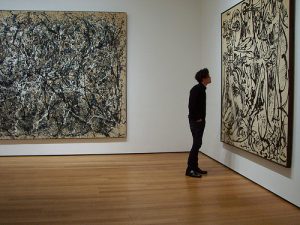The statue of Amunhotep III stood out to me at first because of the color scheme. The gold and brown colors made the figure seem warm and welcoming. With closer look, the figure seemed to be made of wood, different from the fine stone figures usually seen in Egyptian art. This evoked curiosity. Without reading the caption, the figure seemed to be representing an authority, with a magnificent crown and a gold colored kilt. The gate of the figure gave a sense of sophistication and confidence. The figure was small, and stood on a wooden base. Strikingly the figure has no arms, and the left leg is in front of the right, suggesting a sense of motion or even dominance. There seems to be difference in the polish of the head and body, which was interesting. The crown was one of the most complicated woodwork in the figure. The crown is something called the “Blue Crown” which was first seen in Egyptian art only a few generation prior, meaning that it was a relatively new invention. The eyebrows and the eyes are outlined in a purple-blue glass, and eyes in white and black glass. The face is also drawn so realistically, and seems to be lifelike. The male figure was made in the late XVII dynasty, circa 1390-1352. The caption read that the figure was a cult statue made after the death of subject. After some research, I found that wood was pretty expensive and rare and they had to be imported. This shows that this figure was someone of great importance or meant something to the people since it was created after his death. Not surprisingly, Amunhotep III’s reign was a time of peace.
I really enjoyed looking at this piece of art, it really spoke volumes of who the the pharaoh was, and his reign. Though I was first attracted to this piece because of the color, the art revealed to me so much history and purpose that I didn’t know. Definitely a great experience.












